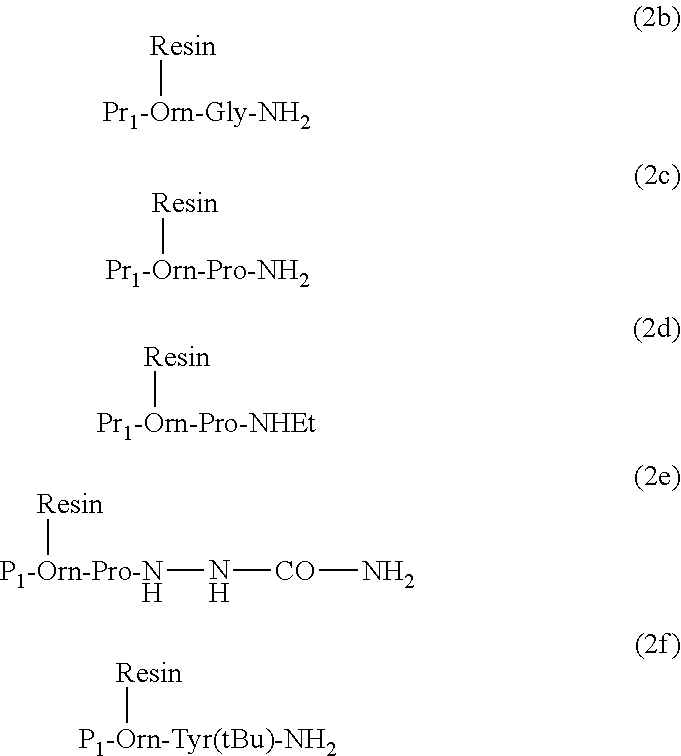Peptide-resin conjugate and use thereof
- Summary
- Abstract
- Description
- Claims
- Application Information
AI Technical Summary
Benefits of technology
Problems solved by technology
Method used
Image
Examples
example 1
Synthesis of Atosiban Starting from Fmoc-Orn-Gly-NH2 Attached Through the Side Chain of Ornithine on the Trityl Resin
[0292]
[0293]Trityl chloride resin (20.0 g; loading 24.4 mmol) of trityl chloride resin was placed in a peptide synthesis reactor and swelled with 200 mL DCM / DMF (1:1) for 30 min at 25° C. Then 4.63 g (10 mmol) of Fmoc-Orn-Gly-NH2.HCl—produced by procedures known in the art from Fmoc-Orn(Boc)-Gly-NH2 and HCl in dioxane—were added. The mixture was shacked over night at RT. Then, the remaining active sites of the resin were neutralised by adding 10 mL of methanol (MeOH) and reacting for additional 2 h at RT. The resin was then filtered and washed 4× with 400 mL DMF, deswelled with 3 washes of 500 mL isopropanol (IPA) and 4×400 ml DEE and swelled again in DMF. Then, the peptide chain elongation was performed according to the standard procedures using Fmoc-Pro-OH, Fmoc-Cys(Trt)-OH, Fmoc-Asn(Trt)-OH, Fmoc-Thr(Trt)-OH, Fmoc-Ile-OH and Fmoc-D-Tyr(Et)-OH. The N-terminal S-Trt-...
example 2
Synthesis of Atosiban Starting from Fmoc-Orn-OH Attached Through the Side Chain of Ornithine on the 4-Methoxy Resin
[0294]1 mmol of Fmoc-Orn-OH was dissolved in 15 ml DCM. Then, 1.5 mmol of DIPEA was added and 1 g 4-methoxytrityl resin (1.2 mmol / g) and the mixture stirred overnight. 1 ml methanol was added and the mixture was stirred for an additional 4 hours at RT. The resin was then filtered, washed 3×DCM, 3×DMF, 3×iPrOH and 3×hexane and dried in vacuum to constant weight to give Fmoc-Orn(4-methoxytrityl resin)-OH.
[0295]2.0 g (1.0 mmol) of Fmoc-Orn(4-methoxytrityl resin)-OH were suspended in 10.0 ml DMF, cooled to 5° C. and reacted with 0.18 g (1.3 mmol) HOBt and 0.13 g (1.0 mmol) DIC. The mixture was shacked for 5 min at 5° C. and then warmed up to 15° C. Then 0.22 g (2 mmol) glycine amide hydrochloride and 0.39 g (3.0 mmol) DIPEA were added and the mixture was shacked for 90 min at RT. The procedure was repeated and the obtained Fmoc-Orn(4-methoxytrityl resin)-Gly-NH2 was used fo...
example 3
Synthesis of Resin-Bound Fmoc-Orn-Pro-NH2, Fmoc-Orn-Pro-NHEt and Fmoc-Orn-Pro-NH—NH—CO—NH2, General Procedure
[0296]Fmoc-Orn(Boc)-OH or Fmoc-Orn(Mtt)-OH or Fmoc-Orn(Mmt)-OH were coupled by methods known in the art with H-Pro-NH2 or H-Pro-NHEt or H-Pro-NH—NH—CO—NH2. The obtained product was then side chain deprotected with TFA in DCM. The obtained well dried ornithine dipeptide 10.0 mmol was then dissolved in 100 ml DCM / DMF (1:1). This solution was then added to 10.0 g of 2-chlorotrityl- or trityl-, or 4-methyltrityl- or 4 methoxytrityl-chloride resin (loading=0.9-1.6 mmol / g) and to the obtained mixture 30.0 mmol DIPEA were added. The mixture was then shacked for 12 h at RT and then 5.0 ml MeOH were added and the mixture was shacked for additional 2 h at RT. The resin was then filtered and washed 6× with DMF, 3×IPA and 3×DEE, and dried in vacuum to constant weight. Yield 12.5-14.5 g with a total loading of 7.9-8.7 mmol.
PUM
| Property | Measurement | Unit |
|---|---|---|
| Time | aaaaa | aaaaa |
Abstract
Description
Claims
Application Information
 Login to View More
Login to View More - R&D
- Intellectual Property
- Life Sciences
- Materials
- Tech Scout
- Unparalleled Data Quality
- Higher Quality Content
- 60% Fewer Hallucinations
Browse by: Latest US Patents, China's latest patents, Technical Efficacy Thesaurus, Application Domain, Technology Topic, Popular Technical Reports.
© 2025 PatSnap. All rights reserved.Legal|Privacy policy|Modern Slavery Act Transparency Statement|Sitemap|About US| Contact US: help@patsnap.com



